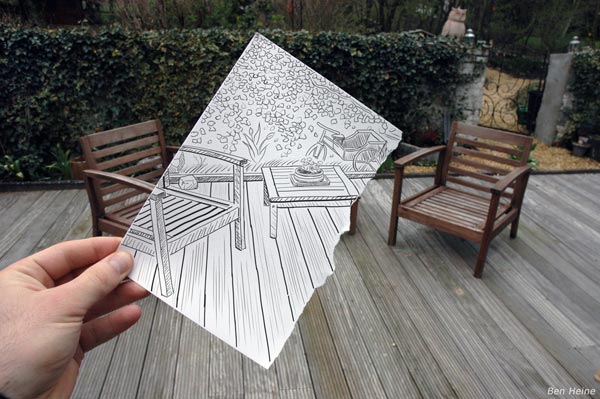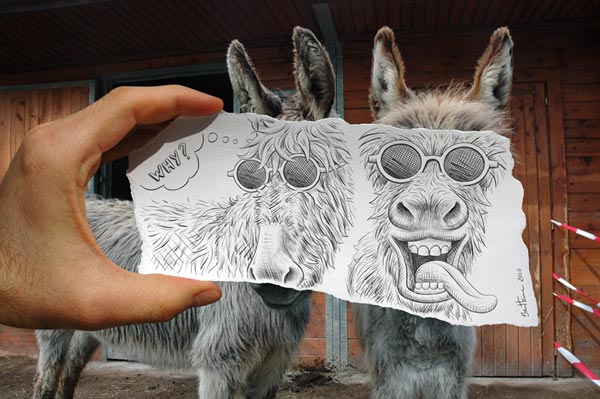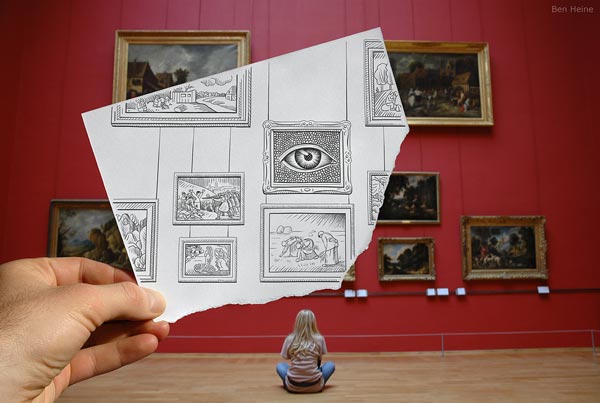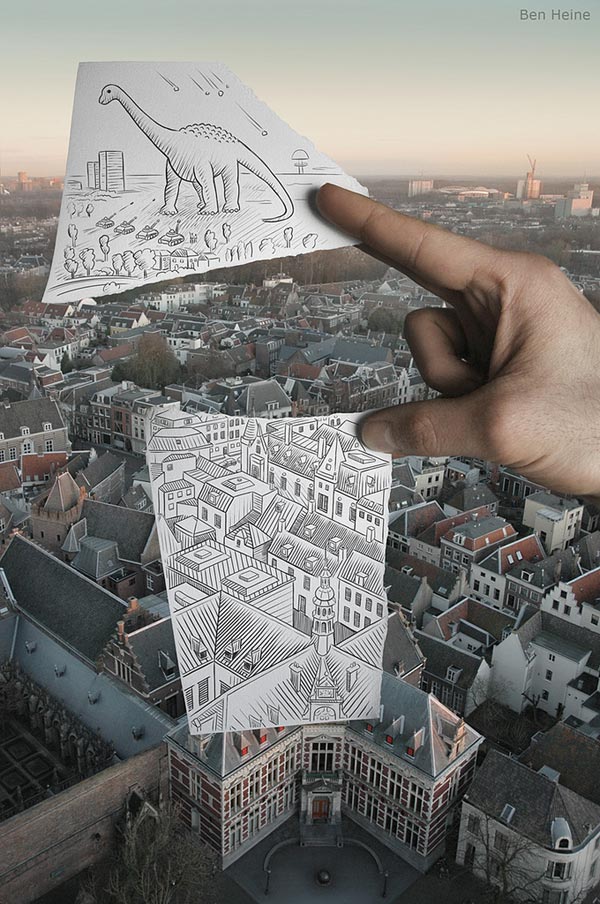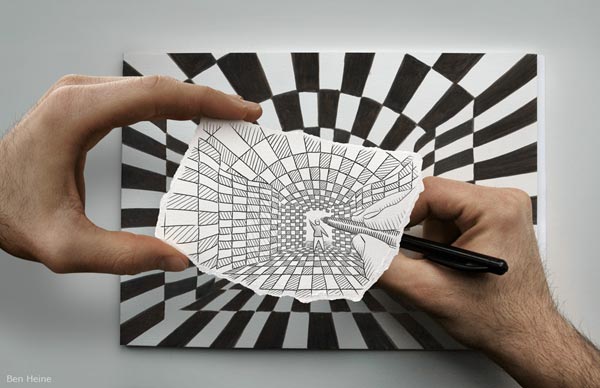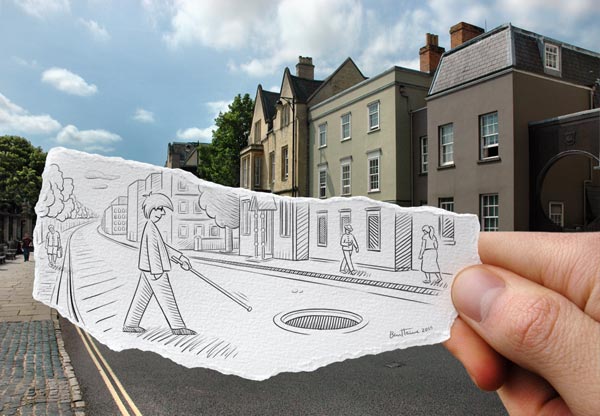Saya menemukan karya kreatif ini dari Kipkay.com. Judul aselinya adalah Cheapy Lighter Laser Burner yang artinya kurang lebih Cahaya Laser Pembakar Murah.. :D Jika ada yang tahu makna yang benar tolong comment di box bawah.. :D. Silahkan di jalan kan video berikut ini.
Jika anda kurang paham artinya, saya akan mencoba mentranslatenya kemudian. Tapi tidak sekarang, karena saya belum sempat.. :D
Gambar Kreatif : Gabungan Photografi dan Sketsa
Ketika saya sedang "iseng" ber stumble ria, saya terdampar di sebuah website gallery. Dan kemudian saya melihat gambar - bambar kreatif di bawa ini.
Gambar - gambar keren di bawah ini merupakan karya kreatif dari seorang pelukis Belgia, seorang Ilustrator, karikaturis, dan photografer, Ben Heine.
Seniman kreatif ini dilahirkan di Abidjan, Ivory Coast. Dia belajar seni menggambar dan seni memahat dan dia juga seorang jurnalis. Mari kita lihat karya - karya kreatifnya, yang dia sebut “Drawing Vs Photography” or “Imagination Vs Reality”.
Sebenarnya saya tahu bahwa banyak juga karya seniman - seniman Indonesia yang mungkin lebih keren dari ini, namun sayangnya saya jarang menemukannya di Internet. Apakah saya yang kurang informasi atau memang jarang dipublikasikan di Internet. Semoga saja kedepan saya bisa lebih sering melihat karya - karya seniman Indonesia di Internet. Bagi saudara - saudara pengunjung yang mengetahui letak website yang menampilkan karya - karya putra Indonesia mohon di share di sini ya..
Semoga posting ini memberikan Inspirasi bagi Pengunjung sekalian.. :D
tag : foto kreative, gambar keren, sketsa, fotografi.
Gambar - gambar keren di bawah ini merupakan karya kreatif dari seorang pelukis Belgia, seorang Ilustrator, karikaturis, dan photografer, Ben Heine.
Seniman kreatif ini dilahirkan di Abidjan, Ivory Coast. Dia belajar seni menggambar dan seni memahat dan dia juga seorang jurnalis. Mari kita lihat karya - karya kreatifnya, yang dia sebut “Drawing Vs Photography” or “Imagination Vs Reality”.
Sebenarnya saya tahu bahwa banyak juga karya seniman - seniman Indonesia yang mungkin lebih keren dari ini, namun sayangnya saya jarang menemukannya di Internet. Apakah saya yang kurang informasi atau memang jarang dipublikasikan di Internet. Semoga saja kedepan saya bisa lebih sering melihat karya - karya seniman Indonesia di Internet. Bagi saudara - saudara pengunjung yang mengetahui letak website yang menampilkan karya - karya putra Indonesia mohon di share di sini ya..
Semoga posting ini memberikan Inspirasi bagi Pengunjung sekalian.. :D
tag : foto kreative, gambar keren, sketsa, fotografi.
20 Best Tips To Create A Success Blog
I realize that I'm still not good enough to manage my own blog. But I try to do my best. And today I try to find some trips that can make a blog become more powerful and success. These tips are not a specific tips, but it will give you (especially me) inspiration to improve the quality of our blog. I got this article from thenextweb.com, one of success website. Please enjoy the tips..
1. Have A Clear Business Goal
There is no point writing a blog just for the sake of writing it, you need to have a clear business goal for doing so. Our business goal is simple. we want to raise our profile as an agency internationally while bringing in business leads. Everything we do from design to the content we write is all tied back in to those two goals. Set your own clear goals and stick to them no matter how many other distractions might pop up form day to day.
2. Write Content That People Will Reference
People are very selfish in their reasons for visiting blogs. They will only come to your blog if there is something there for them. Good content, something they can learn from, the latest news or content that they can’t find elsewhere. What you need to try and do is create content that people will reference and pass on to others.3. Give Away Lots Of “Secrets” For Free
The best thing you can do on a blog is give away as much information as you possibly can. If you are writing a business blog there is a good chance that people are reading it or have arrived there via a search engine looking for information. Don’t be scared to give away some of your trade secrets or some advice that you would normally charge for. It might not seem natural to be giving your experience away free online but I’ve found that the more you give away for free the more business you will actually get in return. Strange but true.
4. Show Your Personality
The old saying in social media is that nobody wants to be friends with a logo and the same has to be said of blogs…nobody really wants to read what a logo has to say. Adding personality and showing the human side of your company online is not always easy and most companies are terrified of letting their staff have a voice but people love to hear what other people have to say and having a human touch and some nice personal photos on your blog goes a long way.5. You Don’t Have To Do What People Expect
We are an agency. By right we shouldn’t be giving away free advice. We shouldn’t be helping people with an Ebook. We shouldn’t be posting about controversial content or having a polarizing opinion online. As an agency you are meant to tow the line and post non controversial content a couple of times a week. The point here is that if you try and be like every other blog and outdo the current market leaders by copying them you will never get anywhere. Don’t be scared of standing out from the crowd and creating something that nobody else would have expected.6. Weave Social Media In To Your Blog
Pretty obvious one really these days but social media can help in adding a human side to your blog as well as building community around your business. I would always say to pick 3 social platforms that are relevant to you rather than trying to do them all and spread yourself too thin. Facebook, Twitter and Youtube perhaps? Think of the various social media profiles as the different touch points for your blog and the different paths that people can find you from. Make sure your content is shareable and that you are not always pushing the content out to the same group of people who are subscribed to you via multiple channels.7. Get Some Basic SEO Work Before You Start
All the talk at the moment is about social media and that is great because there is a lot you can do with it but at the end of the day we are a big social media blog with a strong presence across various social channels yet over 70% of our traffic still comes via Google. That is the same for most of the big sites in the world and search engines can’t be ignored. I wouldn’t do SEO from day to day but we had some basic work done at the start by a professional which has done us proud over the last 18 months. Don’t fuss about it every day and certainly don’t write for search engines but do take a little time to get your SEO in order at the start.
8. Focus On Content And Not Design
It’s tempting to spend all your time on design and fiddling about with everything from widgets to the various plugins that you can add to your blog. The best piece of advice I can give you form this whole list is to forget about all that stuff and just focus on content. You’ll want to make sure that your design is slick at the start but people visit blogs to read content and not to look at your lovely shiny widgets in the side bar.9. Make It Easy For People To Contact You
Sounds like a very easy tip but you would be amazed at just how many people make it hard to be contacted on their blog. I can understand it in some cases where you actually don’t want to be contacted and are just blogging for fun but if you are blogging for a business reason then having several simple ways for people to get in touch is essential.10. Be Consistent
There is nothing worse than going to a blog only to see that it hasn’t been updated in a couple of weeks. You don’t need to post every single day like we do here but you do need to set your reader’s expectations. If you only have time to blog once a week then keep it consistent and stick to that.
11. Don’t Just Write About You
As much as you might think it’s exciting for people to read about the awards you win and all the work projects you do don’t just write about you and your work. There is no harm dropping in the odd post or sharing things like new offices or staff arrivals but if you only write about your own company nobody is going to be interested in reading about that day in day out.12. Make Your Blog International
This might not apply to everybody but we try and make our blog international and not Ireland specific. It’s not that we don’t want to focus on the Irish market but by writing about local stories only you essentially pigeon hole yourself as a local blog and limit the size of your potential audience. Think big.
13. Do Some Fun Projects
We always try and do some little fun projects here on the blog like the internet subway map or the video of UK stats and it’s important that you do the same and something that people can share with their networks. They take a lot of research and some extra work in the evenings but they are well worth doing because they get you thinking about your industry in a very different way.14. Praise The Work Of Others Within Your Industry
Don’t think of other people within your industry as competitors. Instead think of them as people with like minded interests who will probably be interested in your content. The world is plenty big to have competitors and still survive so if you see some great work within your industry make sure to highlight it and praise others because the same thing might happen to you one day.15. Mix With The Offline World
Networking online is great but the power of networking in the real world can not be underestimated. Be it speaking at events, attending industry events or just going for a pint with bloggers within your industry it really is a powerful way of highlighting your blog. Don’t be scared to add your blog URL to business cards and other printed material.16. Focus On Subscribers
Subscribers should be the holy grail. What are subscribers? RSS, Email, people who follow your blog on Twitter, Facebook likes or even Youtube subscribers. The important thing about subscribers is that they are people who are saying “yes I like this content and I would love to be alerted as soon as you have some more”. They are not passers by but people who will see your content as soon as you publish it and they are the life blood of your blog. They are the hard core readers!17. Promote Your Blog
This might seem like a very obvious thing to say but it’s amazing how many people build blogs and then just expect people to magically appear there to read it. There are something like 200 million blogs in the world and nobody is going to notice yours unless you promote it a little! Reach out to bigger publications with your best content and don’t be afraid to shout about your blog.
18. Guest Blog
This is one that takes a lot of time and effort but is probably the quickest way of growing the audience on your own blog. The important thing to remember is that you should not just post any old content on other blogs but should always aim to have the best content on to other sites. Pick sites that have large established audiences within the same niche as yourself and offer to write content for them. It’s a way of raising your profile as a blogger and the other blogs will be only to happy to get great free content from you.19. Engage Away From Your Own Blog
Comment. Comment. Comment. It’s one of the most important things that you can do and is all about building relationships with other people within your niche and the best way to do that is through comments. Be thoughtful and actually engage with their content rather than just coming along and saying “great post”. Add to the discussion and show your knowledge and other people will see your passion and knowledge and discover your own blog. It’s also important to realize that people within your own niche will be more likely to read your blog as well given your similar passions and interests.20. Stay Within Your Niche
It’s tempting to write about things that you are passionate about on your blog. I’d love to write about football or sports but I can’t and don’t because this is a social media blog. I’ll often find ways to work it in to the odd blog post but people read your blog because they want to hear the latest news or insight from that industry. Writing off topic will lose you readers and mean you can’t grow as big of an audience.tag : how to increase traffic, effective blog website, make success website
tag : how to make a success business blog website, tips to success website, increase traffic blog, cheat how to increase blog quality
Labels:
Internet,
Tips Triks
9 Best Computer Interfaces
Today, we know that computer has become the most important device in the world. Everywhere, computer being used by people to operate something. In this device, there is a part that so important. The Interfaces that allow people to control the computer. Today, I try to search the explanation about it, and found an article from technology review that owned by MIT. This article explain about the computer interfaces from the past until future. I also put some picture to make you understand what the kind of interfaces that explained below. I hope you will enjoy it.
Command Line
The granddaddy of all computer interfaces is the command line, which surfaced as a more effective way to control computers in the 1950s. Previously, commands had to be fed into a computer in batches, usually via a punch card or paper tape. Teletype machines, which were normally used for telegraph transmissions, were adapted as a way for users to change commands partway through a process, and receive feedback from a computer in near real time.Video display units allowed command line information to be displayed more rapidly. The VT100, a video terminal released by Digital Equipment Corporation (DEC) in 1978, is still emulated by some modern operating systems as a way to display the command line.
Graphical user interfaces, which emerged commercially in the 1980s, made computers much easier for most people to use, but the command line still offers substantial power and flexibility for expert users.
The Mouse
Nowadays, it's hard to imagine a desktop computer without its iconic sidekick: the mouse.
Developed 41 years ago byDouglas Engelbart at the Stanford Research Institute, in California, the mouse is inextricably linked to the development of the modern computer and also played a crucial role in the rise of the graphic user interface. Engelbart demonstrated the mouse, along with several other key innovations, including hypertext and shared-screen collaboration, at an event in San Francisco in 1968.
Early computer mouses came in a variety of shapes and forms, many of which would be almost unrecognizable today. However, by the time mouses became commercially available in the 1980s, the mold was set. Three decades on and despite a few modifications (including the loss of its tail), the mouse remains relatively unchanged. That's not to say that companies haven't tried adding all manner of enhancements, including a mini joystick and an air ventilator to keep your hand sweat-free and cool.
Logitech alone has now sold more than a billion of these devices, but some believe that the mouse is on its last legs. The rise of other, more intuitive interfaces may finally loosen the mouse's grip on us.
The Touchpad
Despite stiff competition from track balls and button joysticks, the touchpad has emerged as the most popular interface for laptop computers.
With most touchpads, a user's finger is sensed by detecting disruptions to an electric field caused by the finger's natural capacitance. It's a principle that was employed as far back as 1953 by Canadian pioneer of electronic music Hugh Le Caine, to control the timbre of the sounds produced by his early synthesizer, dubbed the Sackbut.
The touchpad is also important as a precursor to the touch-screen interface. And many touchpads now feature multitouch capabilities, expanding the range of possible uses. The first multitouch touchpad for a computer was demonstrated back in 1984, by Bill Buxton, then a professor of computer design and interaction at the University of Toronto and now also principle researcher at Microsoft.
The Multitouch Screen
Mention touch screen computers, and most people will think of Apple's iPhone or Microsoft's Surface. In truth, the technology is already a quarter of a century old, having debuted in the HP-150 computer in 1983. Long before desktop computers became common, basic touch screens were used in ATMs to allow customers, who were largely computer illiterate, to use computers without much training.
However, it's fair to say that Apple's iPhone has helped revive the potential of the approach with its multitouch screen. Several cell-phone manufacturers now offer multitouch devices, and both Windows 7 and future versions of Apple's Macbook are expected to do the same. Various techniques can enable multitouch screens: capacitive sensing, infrared, surface acoustic waves, and, more recently, pressure sensing.
With this renaissance, we can expect a whole new lexicon of gestures designed to make it easier to manipulate data and call up commands. In fact, one challenge may be finding means to reproduce existing commands in an intuitive way, says August de los Reyes, a user-experience researcher who works on Microsoft's Surface.
Gesture Sensing
Compact magnetometers, accelerometers, and gyroscopes make it possible to track the movement of a device. Using both Nintendo's Wii controller and the iPhone, users can control games and applications by physically maneuvering each device through the air. Similarly, it's possible to pause and play music on Nokia's 6600 cell phone simply by tapping the device twice.
New mobile applications are also starting to tap into this trend. Shut Up, for example, lets Nokia users silence their phone by simply turning it face down. Another app, callednAlertMe, uses a 3-D gestural passcode to prevent the device from being stolen. The handset will sound a shrill alarm if the user doesn't move the device in a predefined pattern in midair to switch it on.
The next step in gesture recognition is to enable computers to better recognize hand and body movements visually. Sony's Eye showed that simple movements can be recognized relatively easily. Tracking more complicated 3-D movements in irregular lighting is more difficult, however. Startups, including Xtr3D, based in Israel, and Soft Kinetic, based in Belgium, are developing computer vision software that uses infrared for whole-body-sensing gaming applications.
Oblong, a startup based in Los Angeles, has developed a "spatial operating system" that recognizes gestural commands, provided the user wears a pair of special gloves.
Force Feedback
A field of research called haptics explores ways that technology can manipulate our sense of touch. Some game controllers already vibrate with an on-screen impact, and similarly, some cell phones shake when switched to silent.
More specialized haptic controllers include the PHANTOM, made by SensAble, based in Woburn, MA. These devices are already used for 3-D design and medical training--for example, allowing a surgeon to practice a complex procedure using a simulation that not only looks, but also feels, realistic.
Haptics could soon add another dimension to touch screens too: by better simulating the feeling of clicking a button when an icon is touched. Vincent Hayward, a leading expert in the field, at McGill University, in Montreal, Canada, has demonstrated how to generate different sensations associated with different icons on a "haptic button". In the long term, Hayward believes that it will even be possible to use haptics to simulate the sensation of textures on a screen.
Voice Recognition
Speech recognition has always struggled to shake off a reputation for being sluggish, awkward, and, all too often, inaccurate. The technology has only really taken off in specialist areas where a constrained and narrow subset of language is employed or where users are willing to invest the time needed to train a system to recognize their voice.
This is now changing. As computers become more powerful and parsing algorithms smarter, speech recognition will continue to improve, says Robert Weidmen, VP of marketing for Nuance, the firm that makes Dragon Naturally Speaking.
Last year, Google launched a voice search app for the iPhone, allowing users to search without pressing any buttons. Another iPhone application, called Vlingo, can be used to control the device in other ways: in addition to searching, a user can dictate text messages and e-mails, or update his or her status on Facebook with a few simple commands. In the past, the challenge has been adding enough processing power for a cell phone. Now, however, faster data-transfer speeds mean that it's possible to use remote servers to seamlessly handle the number crunching required.
Augmented Reality
An exciting emerging interface is augmented reality, an approach that fuses virtual information with the real world.
The earliest augmented-reality interfaces required complex and bulky motion-sensing and computer-graphics equipment. More recently, cell phones featuring powerful processing chips and sensors have to bring the technology within the reach of ordinary users.
Examples of mobile augmented reality include Nokia's Mobile Augmented Reality Application (MARA) and Wikitude, an application developed for Google's Android phone operating system. Both allow a user to view the real world through a camera screen with virtual annotations and tags overlaid on top. With MARA, this virtual data is harvested from the points of interest stored in the NavTeq satellite navigation application. Wikitude, as the name implies, gleans its data from Wikipedia.
These applications work by monitoring data from an arsenal of sensors: GPS receivers provide precise positioning information, digital compasses determine which way the device is pointing, and magnetometers or accelerometers calculate its orientation. A project called Nokia Image Space takes this a step further by allowing people to store experiences--images, video, sounds--in a particular place so that other people can retrieve them at the same spot.
Spatial Interfaces
In addition to enabling augmented reality, the GPS receivers now found in many phones can track people geographically. This is spawning a range of new games and applications that let you use your location as a form of input.
Google's Latitude, for example, lets users show their position on a map by installing software on a GPS-enabled cell phone. As of October 2008, some 3,000 iPhone apps were already location aware. One such iPhone application is iNap, which is designed to monitor a person's position and wake her up before she misses her train or bus stop. The idea for it came after Jelle Prins, of Dutch software development company Moop, was worried about missing his stop on the way to the airport. The app can connect to a popular train-scheduling program used in the Netherlands and automatically identify your stops based on your previous travel routines.
SafetyNet, a location-aware application developed for Google's Android platform, lets user define parts of town that they deem to be generally unsafe. If they accidentally wander into one of these no-go areas, the program becomes active and will sound an alarm and automatically call 911 on speakerphone in response to a quick shake.
Brain-Computer Interfaces
Surgical implants or electroencephalogram (EEG) sensors can be used to monitor the brain activity of people with severe forms of paralysis. With training, this technology can allow "locked in" patients to control a computer cursor to spell out messages or steer a wheelchair.
Some companies hope to bring the same kind of brain-computer interface (BCI) technology to the mainstream. Last month, Neurosky, based in San Jose, CA, announced the launch of its Bluetooth gaming headset designed to monitor simple EEG activity. The idea is that gamers can gain extra powers depending on how calm they are.
Beyond gaming, BCI technology could perhaps be used to help relieve stress and information overload. A BCI project called the Cognitive Cockpit (CogPit) uses EEG information in an attempt to reduce the information overload experienced by jet pilots.
The project, which was formerly funded by the U.S. government's Defense Advanced Research Projects Agency (DARPA), is designed to discern when the pilot is being overloaded and manage the way that information is fed to him. For example, if he is already verbally communicating with base, it may be more appropriate to warn him of an incoming threat using visual means rather than through an audible alert. "By estimating their cognitive state from one moment to the next, we should be able to optimize the flow of information to them," says Blair Dickson, a researcher on the project with U.K. defense-technology company Qinetiq.
source : technologyreview.com, google.com
tag : Computer, interfaces, kind of, gesture interfaces, what is, how computer run,
Prolly Not As Hot As You Think You Are
According to researchers at UCLA, 60% of young men and women consider themselves to be "above average" in the looks department. 28% of women and 30% of men under 30 considered themselves to be between an 8 and a 10... Yikes.
At least half of these women probably consider themselves to be above average looking. A couple of them, even think they're HOT... What a world we live in, right?
Something Romantic
I need some blue dishes for summer...
Ikea shabby and chic bedroom suits my house perfectly, the curve leg dressing table and oval mirror are so pretty in a girl's room.
on me: mossman frilling top, mossman the zahara shirt, lumier ruffle hem skirt and maison martin margiela boots.
Crystal Jade Chinese Restaurant
154 Little Bourke Street,
Melbourne City
96392633
96392633
Labels:
Fashion,
Food,
Ikea,
Margiela,
Restaurant
Chanel Paris Shanghai Show
Chanel Paris Shanghai Collection 2010 Pre Fall Runway Show
Huangpu Park/River - Shanghai
Runway Video
China Doll cluch, Take Away purse, aged metal dragon cuffs, and sequined bags. Extremely well made and very expensive! I've heard the China Doll Clutch sold for USD$9xxx. Love to death!!!
Limited Edition Shanghai Store classic flap in red with Karl's signiture inside.
Amazing! I wish I had one.
Chanel - Paris Shanghai A Fantasy Short Movie
A trip Coco Chanel only made in her dreams
PART I
PART II
PART III
PART IV
source: chanel.com & style.com
This is the eighth Metier D’Arts collection following Paris, Tokyo, New York, Monaco, London and Moscow, all locations which have a link to Chanel.
Although Coco Chanel never visited China, she had a strong interest in Asian arts and antiques and Karl Lagerfeld has therefore brought to life the collection she never had the chance to create.
Shanghai is also the site of Chanel newest boutique, which has opened in the Peninsula Hotel yesterday.
I love to watch these behind the scenes episodes from Chanel Paris Shanghai Show. It's so cool to be in the designe team of Chanel and working with Karl Largerfeld is one of the greatest challenges, at the same time, it must be fun!
Here's my Chanel stone and crystal cuff. It's beyond beautiful...
Labels:
Chanel,
Fashion Show
Subscribe to:
Posts (Atom)



